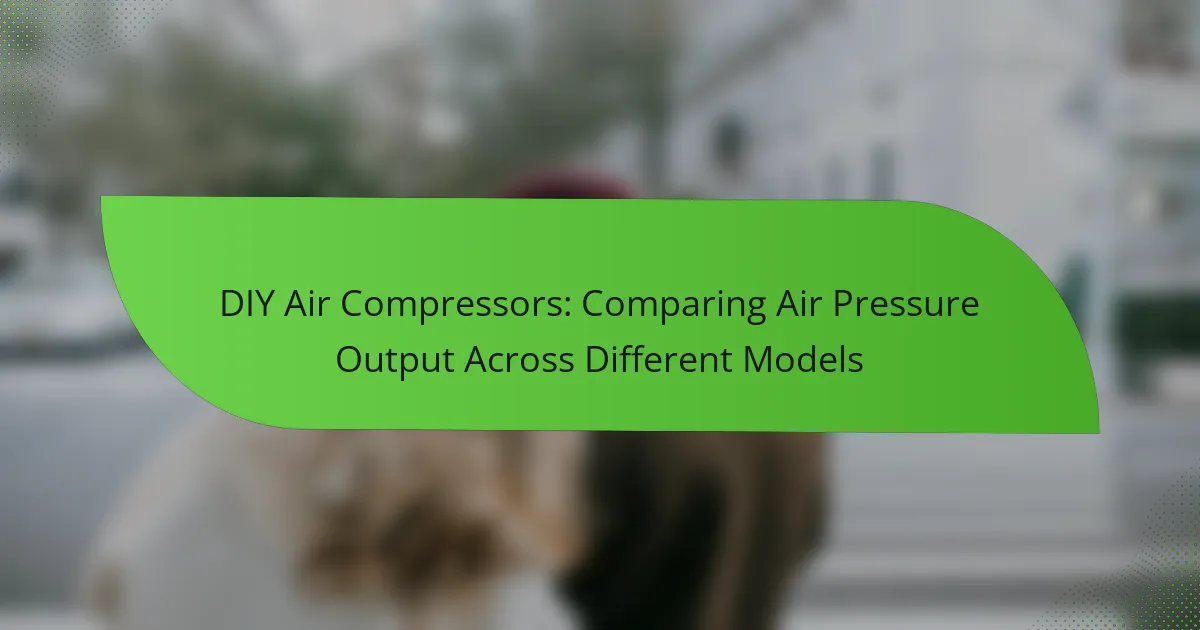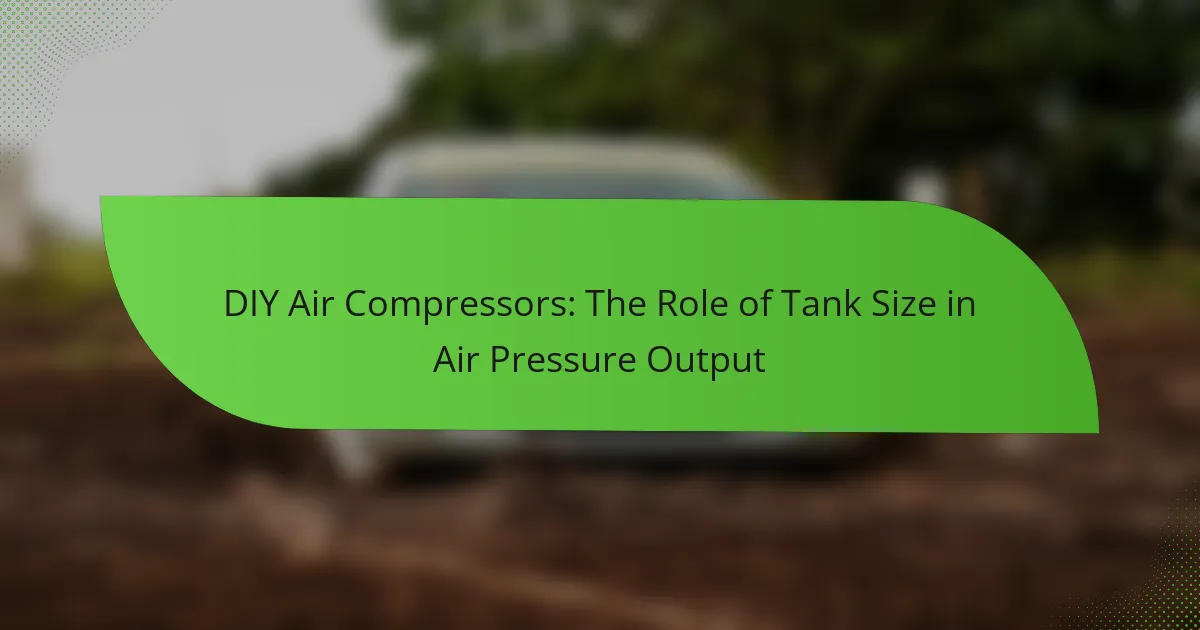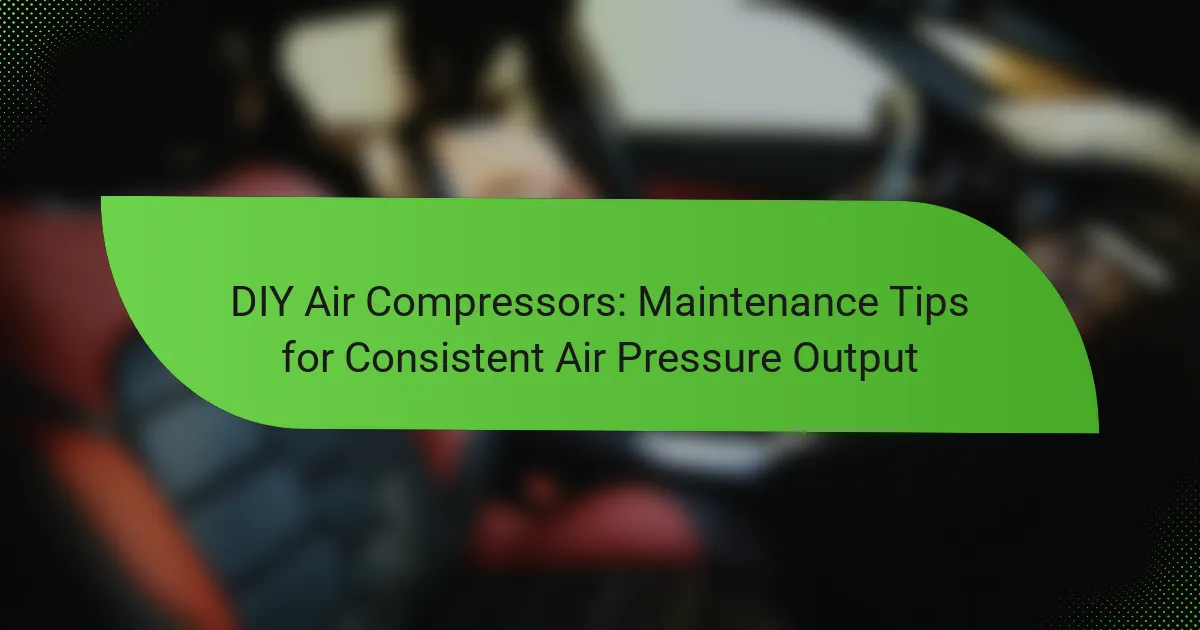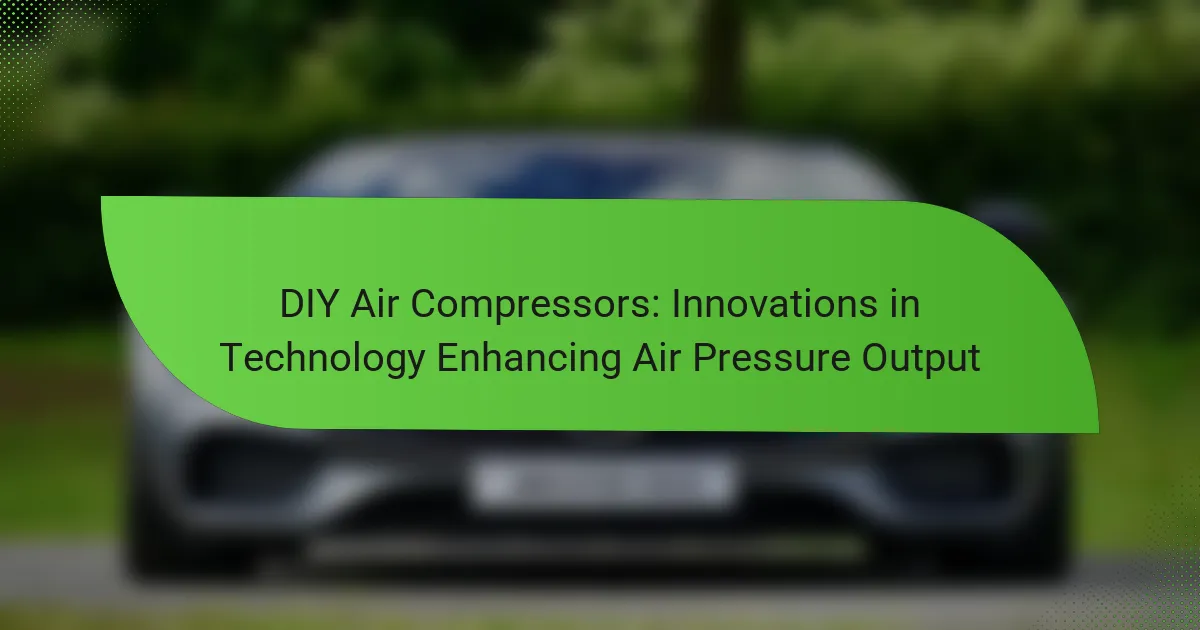DIY air compressors are custom-built devices that compress air for various applications, including tire inflation, powering pneumatic tools, and paint spraying. This article provides a comprehensive overview of common air pressure output issues encountered with DIY air compressors and offers practical troubleshooting steps. Key topics include checking the power supply, inspecting air filters, adjusting pressure regulator settings, and identifying leaks in hoses. Advanced troubleshooting techniques such as systematic component isolation and pressure testing are also discussed to help users effectively address persistent problems. This information aims to assist DIY enthusiasts in optimizing their air compressors for specific tasks.
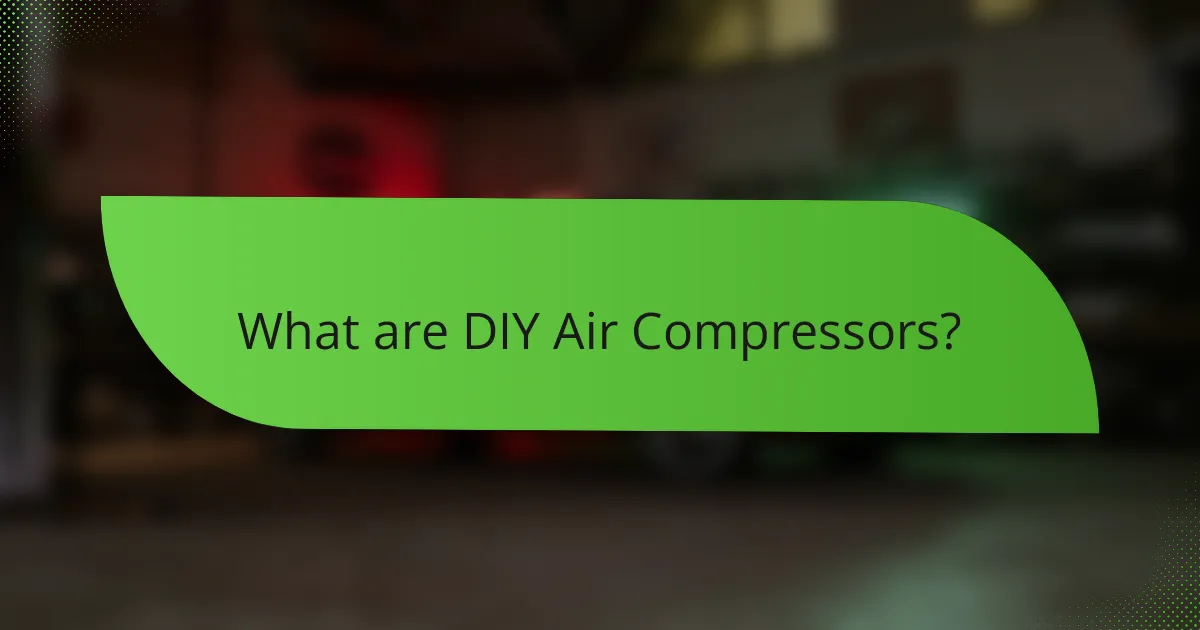
What are DIY Air Compressors?
DIY air compressors are devices created by individuals to compress air for various applications. These compressors can be assembled using readily available components like motors, tanks, and fittings. They serve purposes such as inflating tires, powering pneumatic tools, or spraying paint. DIY air compressors often provide a cost-effective alternative to commercial models. Many enthusiasts build these devices to customize specifications for specific tasks. The construction process typically involves understanding the principles of air compression and safety measures. As a result, DIY air compressors can be tailored to meet unique user needs efficiently.
How do DIY Air Compressors function?
DIY air compressors function by converting power into potential energy stored in pressurized air. They typically use an electric motor to drive a piston or diaphragm. This mechanism compresses air within a tank, increasing the air pressure. The compressed air is then released through a valve for use in various applications. The efficiency of the compressor depends on its design and the materials used. Common designs include reciprocating and rotary screw compressors. Each type has unique attributes affecting performance and pressure output. For example, reciprocating compressors are often used for smaller tasks, while rotary screw compressors are suited for larger applications. Proper maintenance ensures optimal function and longevity of DIY air compressors.
What are the essential components of a DIY Air Compressor?
A DIY air compressor consists of several essential components. The main components include a motor, a pump, a storage tank, pressure gauges, and hoses. The motor powers the pump, which compresses air. The storage tank holds the compressed air for later use. Pressure gauges monitor the air pressure levels within the system. Hoses connect the compressor to tools or equipment. Each component plays a critical role in the overall functionality of the air compressor.
How does each component contribute to air pressure output?
The components of an air compressor each play a crucial role in air pressure output. The motor drives the compressor pump, converting electrical energy into mechanical energy. The pump compresses air, increasing its pressure as it moves through the system. The tank stores the compressed air, maintaining pressure until needed. The pressure switch regulates the system, turning the motor on and off to maintain desired pressure levels. The valves control airflow and prevent backflow, ensuring efficient operation. Filters remove contaminants, protecting internal components and maintaining pressure integrity. Each component’s efficiency directly affects the overall air pressure output of the system.
What common issues affect air pressure output in DIY Air Compressors?
Common issues affecting air pressure output in DIY air compressors include leaks, inadequate power supply, and improper maintenance. Leaks in hoses or fittings can lead to significant pressure drops. An inadequate power supply can prevent the compressor from reaching optimal pressure levels. Additionally, dirty air filters restrict airflow, reducing pressure output. Lastly, worn-out or damaged components can also impair performance. These factors collectively contribute to inefficient air pressure generation in DIY air compressors.
Why do air compressors experience low pressure?
Air compressors experience low pressure due to several factors. Common causes include air leaks in hoses or fittings. These leaks allow compressed air to escape, reducing overall pressure. Another reason is insufficient power supply to the compressor. If the motor does not receive enough electricity, it cannot generate the required pressure. Blocked air filters can also restrict airflow, leading to low pressure. Additionally, worn-out piston rings may cause a loss of compression within the cylinder. Regular maintenance can help prevent these issues and ensure optimal performance.
What are the signs of air leaks in DIY Air Compressors?
Signs of air leaks in DIY air compressors include a noticeable drop in pressure during operation. You may also hear hissing or whistling sounds, which indicate escaping air. Additionally, visible moisture or frost on the compressor can signal a leak. Frequent cycling of the compressor motor may suggest it is working harder due to air loss. Inspecting hoses and fittings for wear or damage can reveal potential leak sources. Using soapy water to check for bubbles around connections can help identify leaks effectively. Regular maintenance can prevent these issues from arising.
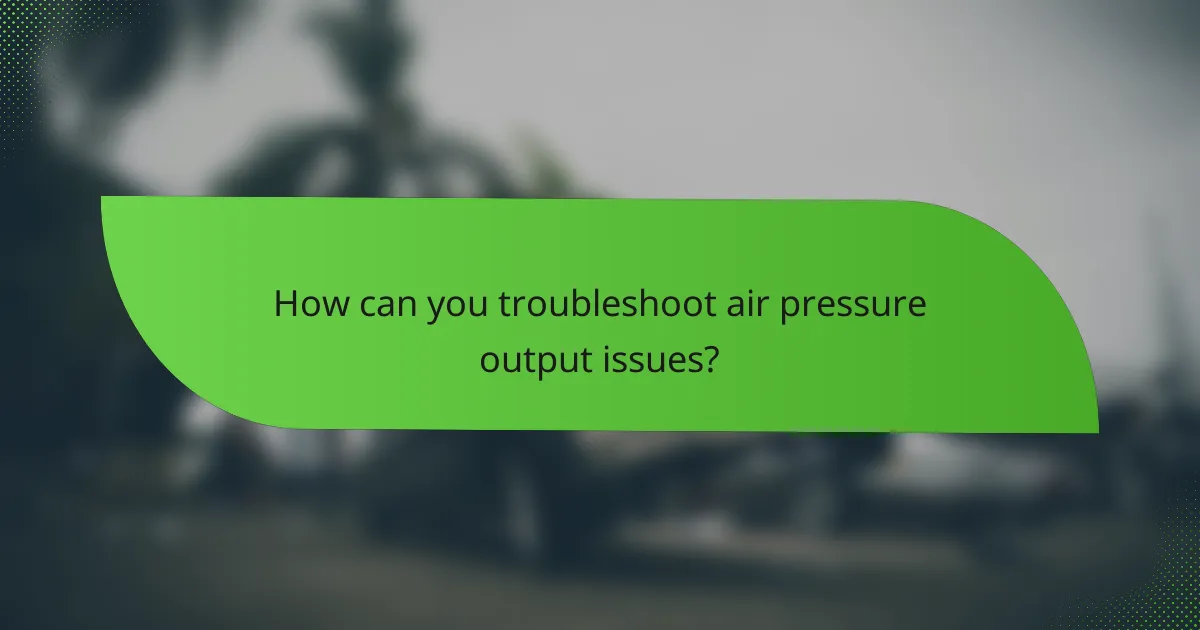
How can you troubleshoot air pressure output issues?
To troubleshoot air pressure output issues, first check the air compressor’s power supply. Ensure it is plugged in and the circuit breaker is not tripped. Next, inspect the air filter for dirt or blockages. A clogged filter can restrict airflow, affecting pressure output. Examine the pressure regulator settings. Incorrect settings can lead to low pressure. Additionally, check for leaks in hoses and connections. Leaks can significantly reduce pressure levels. Finally, verify the compressor’s tank pressure gauge for accuracy. An inaccurate gauge may misrepresent the actual pressure.
What steps should you take to diagnose low air pressure?
To diagnose low air pressure, first check the pressure gauge on the air compressor. Ensure it is functioning properly and accurately reflects the pressure. Next, inspect the air hoses for leaks or damage. Damaged hoses can lead to air loss. Then, examine the fittings and connections for tightness. Loose connections may also cause pressure drops. Additionally, inspect the compressor’s intake filter. A clogged filter can restrict airflow and reduce pressure. Finally, check for any blockages in the air delivery system. Blockages can impede air flow and contribute to low pressure.
How do you check for leaks in your air compressor system?
To check for leaks in your air compressor system, start by visually inspecting all connections and hoses. Look for any signs of wear, cracks, or loose fittings. Next, apply a soap and water solution to suspected areas. Bubbles will form if there is a leak. Additionally, listen for hissing sounds around joints and connections. A pressure gauge can also help identify pressure drops over time. Regular maintenance helps prevent leaks from developing. These methods are commonly used by technicians to ensure system integrity.
What role does the regulator play in air pressure issues?
The regulator controls the air pressure output in air compressors. It ensures that the compressed air is delivered at a consistent pressure level. This is crucial for the proper functioning of pneumatic tools and equipment. Regulators adjust the pressure according to the needs of the application. They can reduce excessive pressure that could damage tools. Proper regulation prevents fluctuations in air pressure during operation. A malfunctioning regulator can lead to inadequate pressure or over-pressurization. Regular maintenance of the regulator is essential for optimal performance.
What maintenance practices can prevent air pressure problems?
Regular maintenance practices can significantly prevent air pressure problems in air compressors. First, check and replace air filters frequently. Clogged filters restrict airflow and reduce pressure. Second, inspect and tighten all fittings and connections. Loose connections can lead to air leaks, causing pressure drops. Third, ensure the compressor’s oil is at the correct level. Low oil levels can affect performance and pressure. Fourth, drain the moisture from the tank regularly. Accumulated moisture can cause corrosion and pressure issues. Finally, schedule routine inspections by a professional. This ensures all components function correctly and maintains optimal pressure levels. These practices are essential for reliable air compressor performance.
How often should you service your DIY Air Compressor?
You should service your DIY air compressor every 3 to 6 months. Regular servicing ensures optimal performance and longevity. During servicing, check for oil levels, air filters, and any signs of wear. Clean or replace filters as needed. Inspect hoses and connections for leaks. Following these steps can prevent major issues. Consistent maintenance keeps your compressor running efficiently.
What are the best practices for maintaining air filters?
Regularly check and replace air filters to maintain optimal performance. Clean filters every month to remove dust and debris. Replace disposable filters every 1-3 months, depending on usage. Use high-efficiency filters for better filtration. Ensure filters fit properly to prevent air leaks. Monitor air quality and filter condition in high-pollution areas. Follow manufacturer guidelines for specific maintenance recommendations. Proper maintenance extends the life of air compressors and improves air quality.

What are some advanced troubleshooting techniques for persistent issues?
Advanced troubleshooting techniques for persistent air compressor issues include systematic isolation of components, comprehensive pressure testing, and detailed inspection of airflow pathways. Systematic isolation involves checking each component individually to identify faults. Comprehensive pressure testing measures the pressure output against manufacturer specifications. Detailed inspection of airflow pathways ensures there are no blockages or leaks. These methods are effective because they target specific areas of concern, allowing for precise identification of persistent problems.
How can you test the motor and pump efficiency?
To test the motor and pump efficiency, measure the input power and the output work. Use a power meter to determine the electrical input power in watts. Measure the flow rate of the pump in gallons per minute (GPM) or liters per minute (LPM) using a flow meter. Calculate the hydraulic power by multiplying the flow rate by the pressure output. Efficiency can be determined by dividing the hydraulic power by the input power and multiplying by 100 to get a percentage. For example, if the input power is 1000 watts and the hydraulic power is 800 watts, the efficiency is 80%. This method provides a clear assessment of how effectively the motor and pump convert electrical energy into mechanical work.
What tools are needed for testing air compressor components?
The tools needed for testing air compressor components include a pressure gauge, multimeter, and leak detection solution. A pressure gauge measures the air pressure within the compressor system. This ensures the compressor operates at the correct pressure levels. A multimeter tests electrical components, verifying their functionality. This tool is essential for diagnosing electrical issues. Leak detection solution identifies leaks in hoses and fittings. This helps maintain efficiency by preventing air loss. Additional tools may include wrenches for adjustments and a vacuum pump for checking seals. These tools collectively enable effective testing and troubleshooting of air compressor components.
How do you interpret the results of your tests?
To interpret the results of your tests, analyze the pressure readings obtained during operation. Compare these readings to the manufacturer’s specifications for optimal performance. If the pressure is below the specified range, it may indicate a leak or malfunction. Conversely, if the pressure exceeds the recommended level, it could suggest a blockage or over-pressurization issue. Document any inconsistencies in performance across multiple tests for a comprehensive assessment. Use these findings to troubleshoot specific components, such as the pressure regulator or hoses. Regular testing can help identify recurring issues and improve overall efficiency.
What are the best resources for DIY Air Compressor troubleshooting?
The best resources for DIY air compressor troubleshooting include online forums, manufacturer manuals, and instructional videos. Online forums like Reddit and specialized DIY websites provide community support and shared experiences. Manufacturer manuals offer specific troubleshooting steps for different models. Instructional videos on platforms like YouTube demonstrate common issues and solutions. These resources are widely used by DIY enthusiasts for effective troubleshooting. They provide practical advice and visual guidance, enhancing the troubleshooting process.
Where can you find community support for DIY air compressor projects?
You can find community support for DIY air compressor projects on online forums and social media groups. Websites like Reddit have dedicated subreddits such as r/DIY and r/aircompressors. These platforms allow users to share experiences, ask questions, and seek advice. Additionally, Facebook groups focused on DIY projects often feature discussions about air compressors. YouTube also hosts numerous channels that provide tutorials and community interaction. These resources collectively create a supportive environment for DIY enthusiasts.
What manuals or guides are recommended for troubleshooting?
The recommended manuals for troubleshooting DIY air compressors include the “Air Compressor Troubleshooting Guide” by the American Society of Mechanical Engineers. This guide provides step-by-step solutions for common issues. The “Service Manual for Air Compressors” by Ingersoll Rand also offers detailed troubleshooting procedures. Additionally, the “DIY Air Compressor Repair Manual” by Popular Mechanics covers various troubleshooting techniques. These manuals are validated by industry standards and user reviews, ensuring their reliability for effective troubleshooting.
What practical tips can help improve air pressure output?
To improve air pressure output, regularly check and replace air filters. Clogged filters can restrict airflow, reducing pressure. Ensure the compressor is set to the correct pressure level for your needs. Adjusting the regulator can optimize performance. Inspect hoses and connections for leaks. Leaks can significantly decrease pressure output. Use high-quality hoses that can withstand pressure without expanding. Keep the compressor clean and well-maintained. A clean unit operates more efficiently. Lastly, consider upgrading to a larger compressor if requirements exceed current capacity. Larger units can provide higher pressure outputs more consistently.
DIY air compressors are self-assembled devices designed to compress air for various applications such as inflating tires and powering tools. This article provides a comprehensive overview of DIY air compressors, focusing on their functionality, essential components, and common issues affecting air pressure output. Key topics include troubleshooting techniques for low pressure, maintenance practices to prevent problems, and resources for effective repairs. The article aims to equip readers with the knowledge needed to enhance the performance and longevity of their DIY air compressors.
